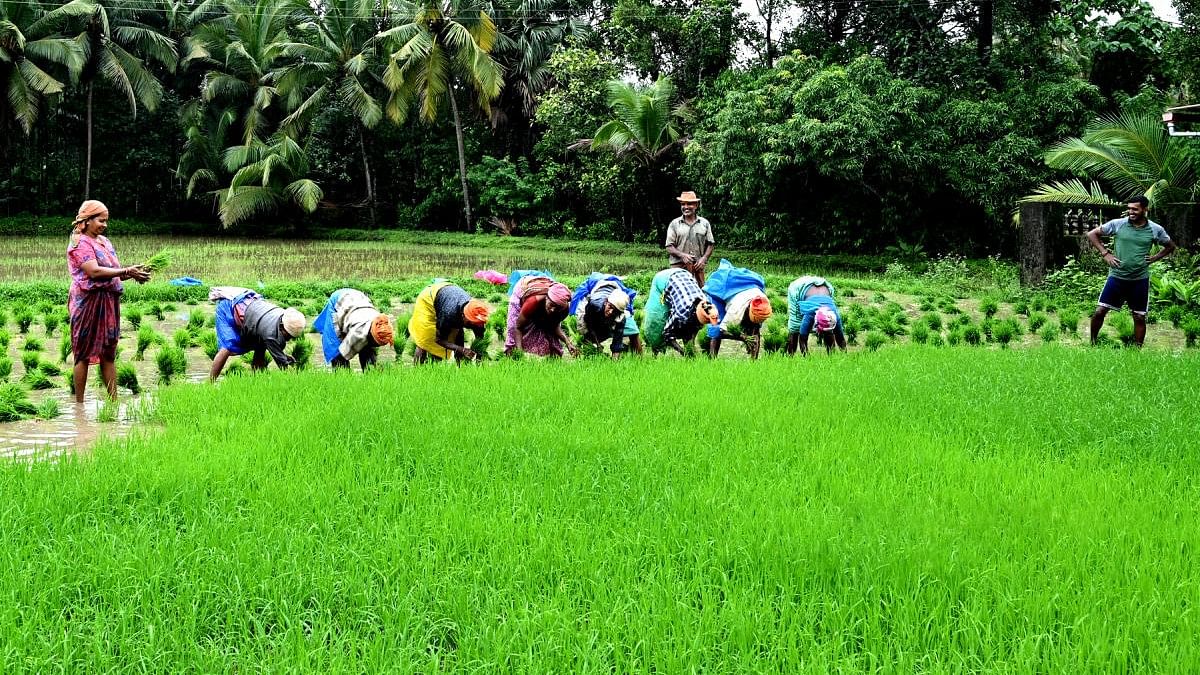
Tulu folk songs called paddana are sung during paddy transplantation.
Credit: DH Photo
With several rounds of summer showers to boast of, the month of May brought joy and much-needed respite from the heat to residents of the state. On the precipice of the monsoon season, many agrarian communities have already started singing to the rain gods in anticipation and hope, after a tough year of drought.
Farming communities have an inextricable relationship with the rains. Close to 60 per cent of land in the state continues to depend on the natural water cycle to sustain crops. As a result, pastoral communities develop a complex association with rain — one rife with hope, disappointment, anger, sadness and distress.
“Water is life-giving and this features in written traditions. Janapada (folklore) has a vast anthology of songs related to the vagaries of nature. This is because these communities are not only dependent but also spend much of their lives exposed to the natural elements,” says Vrushabendrachar, a researcher on the traditions of folk rain songs.
Sung in the fields, at the hearths of homes or at the heart of villages, these songs articulate the intricate relationships of dependence. Songs of celebration describe fields that have come alive with the rain, of raindrops that shimmer like pearls on leaves and the smell of the fields.
“Rain songs are sung in different settings. In anticipation of the rains, when rains first arrive or when there is a lack of rain. Another interesting setting is of the fields, where farmers have formed folk songs that describe the task in great detail,” says Vishweshwari Hiremath, co-founder of the Janapada Samshodhana Kendra in Dharwad.
One folk song named nadi namholakke (come let us go to our fields) goes: Maleraya banda, maleyannu thanda, biduvilla raithara holadaaga. Renti hodeyalu beku, kanti kadiyalu beku, bitthabeku bhoomi hadanagi. (Maleraya has come, bringing rain, there are no breaks for farmers now. The plough needs to hit the ground, the weeds need to be cut, and sowing must be done on the land).
The song goes on to describe how wheat stalks are gathered and transplanted — let us transplant the wheat and put it in the field and plant it in four pairs of coloured sticks.
Folk songs based on rain are usually addressed to Maleraya or the ‘lord of the rains’. While some believe that Maleraya is the king of Hindu gods, Indra, others believe that he is the rain, personified as a man. His counterpart, Gangamma, is the goddess of water. “By engaging with Maleraya directly, folk songs often resemble a dialogue with the natural elements,” says Arun Joladakudligi, a folk researcher.
Ode to the clouds
Agroecological knowledge is also embedded in some songs addressed to Maleraya. Hiremath explains that some clouds are classified as ‘good’ or ‘bad’ according to time of formation, appearance and size. “There are five to six different types of clouds that are mentioned in folk songs across India,” she says.
Folk culture also differentiates between types of rain — demarcating monsoon into many ‘mini seasons’. “Even these mini seasons have positive or negative connotations. Some households and castes are also thought to be particularly associated with a mini season,” explains Joladakudligi. When the mini season approaches, singers visit households to perform the associated songs. For instance, in Dharwad, the ‘Mrugashira male’, rain in the mini-season of mrugashira, is thought to reside in the house of the Vaishyas.
A unique crop of sayings and phrases have also formed in this socio-cultural context. “They say Rohini maleyalli roga illa (There will be no illnesses during Rohini male). Rohini male usually occurs during May,” says Joladakudligi.
Invitation and mourning
Although a significant proportion of rain songs issue invitations to Maleraya, during particularly arid months, there is another sad anthology that pastoral communities access. These songs mourn the loss of income and food and tell the tale of hardship and distress in the heartland.
For instance, in the song barale maleye, suriyale maleye, the singer describes how the land and cattle have become forlorn and lonely in the absence of rain.
Folk songs pursue themes of poverty and an inability to sustain agricultural practice to a morbid end. The song goes: Okkalagyeraga maleraja, avaru makkalu maryara maleraja, makkala mari rokkahidikondu batthentha thirigyara maleraja (The Okkaligas have sold their children. After selling children, holding cash in hand, they head towards the rice fields).
“Stories of sacrifice, murder and of selling children are common in songs of distress. These sacrifices were believed to appease Maleraya or Gangamma,” says Joladakudligi. The stories signify the desperation of ancestral pastoral communities. In the absence of scientific reasoning, they believed that ritualistic sacrifice would put an end to droughts. Instances of sacrifice sometimes have inspired folk songs.
A local song, for example, tells the story of Kallenakeri’s Mallanagowda. After having built a lake, Mallanagowda is distraught with the lack of rains and the lake has gone dry.
Mallanagowda seeks the counsel of an astrologist who says the sacrifice of his eldest daughter-in-law will bring rains to the village. However, fearing that the household will descend into a disarray, Mallanagowda decides that his youngest daughter-in-law would be more suited to the sacrifice.
By nature, folk songs are community projects. They are continually interpolated by each generation, as artists reinterpret and adapt these traditional melodies to reflect contemporary contexts or perspectives.
“I tried to trace the origin of the song and was able to find descendents of the family mentioned. However, they belong to a Dalit family, but the song mentions an Okkaliga family,” adds Joladakudligi. Interpolations that misrepresent communities also signify the politics of caste hierarchies and respectability that remain a reality to this day.
Ultimately, rain songs mirror the socio-cultural practices and beliefs of rural communities. While this can mean that the beauty of nature and its elements is articulated, exploitative social structures and blind beliefs that continue to persist today are also reflected in folk songs.